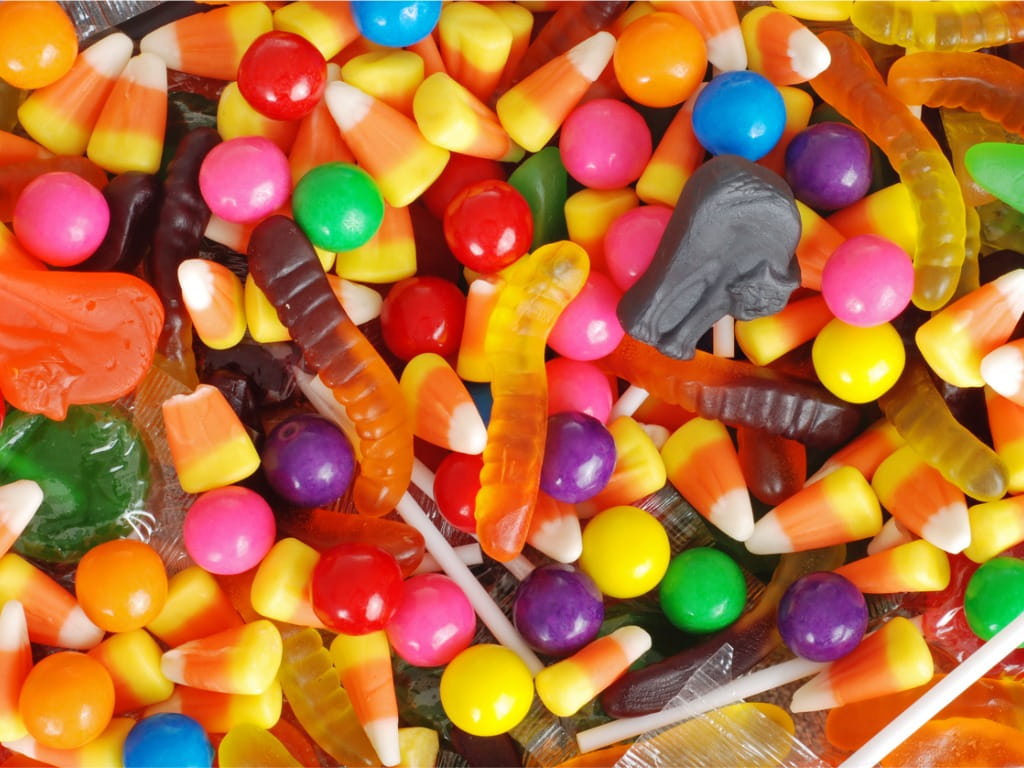Can Halloween Candy Poison Me?

The Bottom Line
Halloween is a holiday synonymous with costume contests and consumption of sugary candy. Eating certain types of sweets, including black licorice and sugar free candy, may result in unwanted toxic effects for trick-or-treaters. Consumption of cannabis edibles or rainbow fentanyl, which may resemble familiar candy or snack products, can also cause dangerous toxicity.

Where does black licorice come from?
Black licorice is produced from the root extracts of the Glycyrrhiza glabra plant, which grows in Asia and the Mediterranean countries. To make licorice, the roots of the Glycyrrhiza plant are dug up from the ground, dried, and crushed to make an extract. The extract is then dried into a paste, from which recognizable sticks of licorice are crafted.
What is black licorice made of?
Black licorice contains nearly 300 different compounds, but its main ingredient is a biologically active and highly sweet-tasting chemical called glycyrrhizin. Although glycyrrhizin is almost 50 times sweeter than refined sugar, its brownish color limits its use as a sweetener in the food and beverage industry. Glycyrrhizin has good foaming properties, and is sometimes used to reduce the bitter taste of beer. Glycyrrhizin is also used as a flavor enhancer in cocoa, pharmaceuticals, and tobacco products.
Is black licorice good or bad for you?
When consumed in moderation, black licorice generally does not cause harmful health effects. Licorice is associated with many potential health benefits including anti-ulcer activity and protection against cancer, liver disease, and some viruses. Licorice’s metabolites also affect cortisol activity in the human body, which can cause water retention, high blood pressure, and low blood potassium levels. Due to its effects on potassium levels, consumption of large amounts of licorice can cause life-threatening abnormal heart rhythms.
What’s in sugar free candy?
The sweet flavors of sugar free candy are due to the presence of carbohydrates called “sugar alcohols”. Sorbitol, xylitol, and mannitol are examples of sugar alcohols. These compounds contain fewer calories than traditional sugars and are not known to cause dental cavities. Because sugar alcohols are not always as sweet as traditional sugars, they may be blended with artificial sweeteners to achieve a recognizable “sugary” taste.
Can sugar free candy make you sick?
Consumption of too much sugar free candy can result in intestinal gas and diarrhea. The sugar alcohols present in sugar free candy are not completely absorbed by the human gastrointestinal system. They pass through the small intestine into the large intestine (colon), where they are broken down by intestinal bacteria into hydrogen gas. Due to this, people who eat large amounts of sugar free candy may experience excessive gas. Additionally, as sugar alcohols pass through the gastrointestinal tract, they interfere with the intestines’ absorption of water, which can result in diarrhea.
How much sugar free candy is bad for you?
Some individuals are more sensitive than others to the gastrointestinal side effects of sugar alcohol consumption. While some people may be able to eat up to 20 grams of sugar alcohols a day without developing unwanted symptoms, others may develop gastrointestinal distress after consumption of smaller amounts.
What is rainbow fentanyl?
Rainbow fentanyl is term used to describe brightly colored fentanyl pills. Rainbow fentanyl was initially discovered in the United States in the summer of 2022, when the United States Drug Enforcement Agency (DEA) seized the drug in at 18 different states.
What does rainbow fentanyl look like?
Rainbow fentanyl is colorful in appearance and can look like pills, powder, or pieces of sidewalk chalk. Rainbow fentanyl pills may contain markings that resemble prescription drugs such as oxycodone.
Why is rainbow fentanyl so dangerous?
Rainbow fentanyl is a type of fentanyl, a powerful opioid drug that is approximately 100 times more potent than morphine. Brightly colored rainbow fentanyl pills may be attractive to children and adolescents, and some individuals may confuse rainbow fentanyl for candy. In September 2022, two men from Maryland were charged with trafficking fentanyl pills into Connecticut. When the men were caught, DEA agents found the fentanyl pills packaged in Nerds candy boxes and Skittles candy bags.
What are different types of edibles?
The term “edibles” refers to food products infused with cannabis, delta-8 THC, cannabidiol (CBD) or other ingredients. Edibles are available in many formulations, including gummies, brownies, and drinks. Since edibles are not regulated by the United States Food and Drug Administration or state health departments, the exact ingredients in edible products are often unknown, and what’s listed on the package label may not be what’s actually in the product
Are edibles legal?
The possession, use, and sale of cannabis is illegal on the federal level, although many states have decriminalized cannabis. Most states allow the sale of cannabidiol (CBD), as long as it contains less than or equal to 0.3% tetrahydrocannabinol (THC). Because of this, CBD edibles (as well as edibles containing delta-8 THC, delta-10 THC, and other minor cannabinoids) are often available for sale at tobacco/vape retailers or convenience stores.
Do edibles look like real candy?
Because they are not heavily regulated by state or federal governments, the packaging of edible products can resemble packaging of well-known brands of candies and other snack foods (including Doritos and Sour Patch Kids) that are attractive to children. Some of these lookalike products are available for sale online, and anyone with internet access can create and sell edible products in packaging that strongly resembles that of popular brands.
What happens if a child eats an edible?
Children who consume cannabis edible products can develop lethargy, difficulty walking, an abnormally fast or slow heart rate, and muscle weakness. In some cases, children who consume cannabis-containing edibles may require hospitalization or admission to an intensive care unit.
How do I know if Halloween candy contains cannabis?
Many cannabis-containing products contain images or labeling on the packaging that indicates the presence of cannabis. Homemade cannabis products may not contain this labeling and should be consumed with caution, and stored where children cannot see or reach them.
What should I do if Halloween candy makes me sick?
If you experience adverse or unexpected symptoms from consuming Halloween candy or other treats, get guidance from Poison Control immediately. Help from Poison Control is available at poison.org and by phone at 1-800-222-1222. Both options are free, confidential, and available 24 hours a day.
Kelly Johnson-Arbor, MD
Medical Toxicologist
For media inquiries, please contact Krista Osterthaler at osterthaler@poison.org.
Poisoned?
Call 1-800-222-1222 or
Prevention Tips
- Eat only factory-wrapped candy and avoid consumption of homemade Halloween treats.
- Consume candy products in moderation.
- Read all package labels carefully to understand ingredients present in candy.
This Really Happened
A 54-year-old man lost consciousness while at a fast-food restaurant. When first responders arrived, he was in cardiac arrest. After administration of CPR and epinephrine, he regained a heart rhythm but remained unresponsive. He was taken to a hospital, where he was found to have an abnormally low blood potassium level. After his family arrived at the hospital, doctors learned that he ate a poor diet, including candy, on a daily basis. His family reported that he had recently switched from eating fruit-flavored candy to licorice-flavored candy, and that he had consumed several bags of the candy daily in the three weeks prior to his hospital admission. He was treated with potassium supplementation, but his condition worsened, and he died less than 2 days after the initial cardiac arrest.For More Information
Eat Any Sugar Alcohol Lately? (Yale New Haven Health)
Edible Marijuana Dangers: How Parents Can Prevent THC Poisoning (Healthy Children)
References
Poisoned?
Call 1-800-222-1222 or
Prevention Tips
- Eat only factory-wrapped candy and avoid consumption of homemade Halloween treats.
- Consume candy products in moderation.
- Read all package labels carefully to understand ingredients present in candy.
